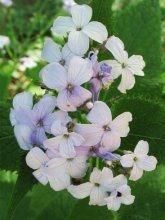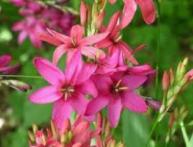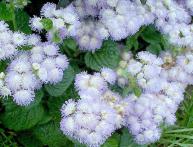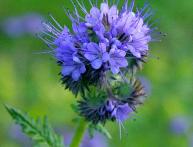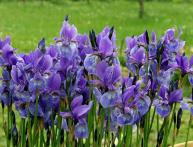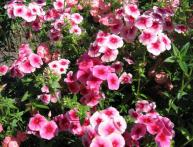Moonflower coming to life: growing in the garden

The reviving moonflower is an ancient plant that prefers moist, shady forests located on the banks of reservoirs. The plant is classified as a rare species and is listed in the Red Book. Lunnik or otherwise Lunaria is valued for its fruits - in the form of moons, which I use for making winter bouquets and compositions. Many growers grow this plant in its garden plots.
Content
Moon plant
The reviving moonflower is a perennial plant belonging to the cabbage family. It grows throughout Europe and in the central part of Russia:
- in Moscow
- Leningradskaya
- Smolensk
- Tula
- Tverskaya
- Novgorod regions
Lunar has unusual large moon-shaped fruits of silver color. For which it is highly valued by lovers of dead wood. Bouquets formed from Lunnik can last throughout the winter. In addition, the plant has healing properties properties.
It is used in the treatment of the gastrointestinal tract and excretory system. The plant regulates blood pressure and reduces capillary fragility.
Lunaria bushes can reach up to half a meter in height; in nature they can grow up to one meter. The lower leaves are heart-shaped. They are painted dark green. The stem has the following characteristics:
- straight
- rough to the touch
- has pubescence in the form of white hairs
In the first year of life, the plant begins to form a leaf rosette, and in the second year it blooms. It blooms with white or purple inflorescences, the flowers have a fragrant aroma. The flowering period lasts from May to mid-June. After the plant has finished flowering, fruits begin to form.
How to choose a landing site
The reviving moonflower prefers shaded places. Excess light has a negative effect on it, the plant begins to shrink and turn pale. Lunnik requires a lot of space. This plant loves space. In crowded conditions it will develop poorly and produce few flowers. Lunar plant is not planted in open, windy places; gusts of wind can break the thin tall stem and fragile branches.
Planting options
Lunaria is actively used in landscape design; it can be used to decorate a garden plot. To do this, you can choose one of the most popular planting methods:
- Gravel flower bed, it is formed from gravel or pebbles. Lunnik looks great against a gravel background. The composition can be supplemented with fennel, barley, geranium.
- A clearing in the shade of trees. The flowerbed is formed using aria and fuchsia moons, which also prefers shady areas.
- The Moorish lawn is sown with various meadow grasses. Together with lunaria, chamomile, cornflower, calendula, clover, and cereals are planted.
The reviving lunar plant is characterized by excellent external characteristics. During the flowering period, it will decorate the garden plot, and for the winter you can make elegant compositions from it.
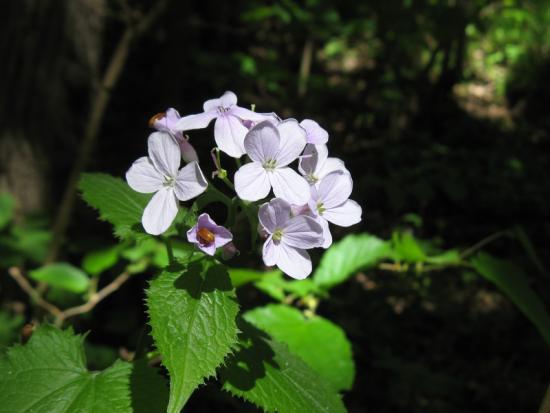
The reviving moonflower is quite whimsical about the composition of the soil. Before planting the plant, you need to dig up the soil well and add humus to it. For 1 sq. meter will require 4 kg of fertilizer.The soil should be loose, nutritious and have good aeration. Loamy and sandy loam soils are suitable for this plant.
Planting and caring for the reviving moonflower
Lunar plant is planted with seeds in open ground. As soon as the frosts are over, they begin sowing. The seeds are planted immediately in a permanent place of growth, since the plant does not tolerate transplantation well. Only the most ripe fruits are selected for sowing; they are brown in color. Lunaria seeds are large and easy to plant immediately in the designated place.
You can choose an autumn planting option. In this case, lunar sow in September, then in the spring it may already bloom, but there will not be many flowers. Mass flowering will begin only in the second year of life.
After the sprouts appear, thinning is carried out if necessary. The flowers should not grow close to each other; a distance of 30 cm should be maintained between the bushes. Young shoots will need to be shaded.
Care

Lunar plant is a winter-hardy plant, so it does not need to be covered for the winter. The plant develops well in a humid environment, but it is important not to allow excess moisture. Lunaria does not tolerate stagnant water in the soil. This flower also does not like spraying.
Drought, heat, and excess sunlight have a bad effect on the condition of the flower. In the wild, the reviving moonflower grows under the cover of broad-leaved forests, which protect it from excess light. Lunnik can be found in floodplains, on the banks of a stream, in a ravine.
Conditions similar to natural ones should be created in the garden plot. The plant is resistant to the invasion of harmful insects. In some cases, the flower may be attacked by a psyllid. To get rid of pest use insecticides.
The reviving moon has a rich history. The plant has been known since the end of the 16th century. In the Middle Ages, it was considered a magical plant that brought wealth and good luck to the house. They carried the fruits of the moonflower with them to increase their well-being. Currently, this flower decorates gardens and city parks.
Video of how the moonflower opens a bud:


